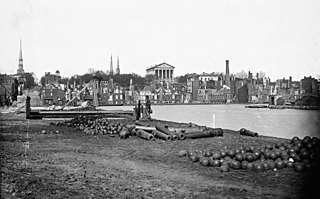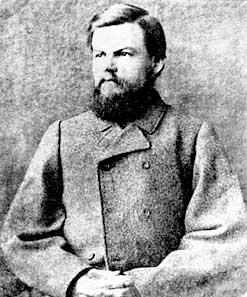
The Battle of the Crater took place during the American Civil War, part of the Siege of Petersburg. It occurred on Saturday, July 30, 1864, between the Confederate Army of Northern Virginia, commanded by General Robert E. Lee, and the Union Army of the Potomac, commanded by Major General George G. Meade.

The Battle of Fort Donelson was fought from February 11–16, 1862, in the Western Theater of the American Civil War. The Union capture of the Confederate fort near the Tennessee–Kentucky border opened the Cumberland River, an important avenue for the invasion of the South. The Union's success also elevated Brig. Gen. Ulysses S. Grant from an obscure and largely unproven leader to the rank of major general, and earned him the nickname of "Unconditional Surrender" Grant.

The Battle of Marais des Cygnes took place on October 25, 1864, in Linn County, Kansas, during Price's Missouri Campaign during the American Civil War. It is also known as the Battle of Trading Post. In late 1864, Confederate Major-General Sterling Price invaded the state of Missouri with a cavalry force, attempting to draw Union troops away from the primary theaters of fighting further east. After several victories early in the campaign, Price's Confederate troops were defeated at the Battle of Westport on October 23 near Kansas City, Missouri. The Confederates then withdrew into Kansas, camping along the banks of the Marais des Cygnes River on the night of October 24. Union cavalry pursuers under Brigadier General John B. Sanborn skirmished with Price's rearguard that night, but disengaged without participating in heavy combat.

The Battle of Mine Creek, also known as the Battle of Little Osage, was fought on October 25, 1864, in Linn County, Kansas, as part of Price's Missouri Campaign during the American Civil War. Major-General Sterling Price had begun an expedition in September 1864 to restore Confederate control of Missouri. After being defeated at Westport near Kansas City on October 23, Price's army began to retreat south through Kansas. Early on October 25, Price's army was defeated at the Marais des Cygnes. After Marais des Cygnes, the Confederates fell back, but were stalled at the crossing of Mine Creek while a wagon train attempted to cross.

Jacob Thompson was the United States Secretary of the Interior, who resigned on the outbreak of the American Civil War and became the Inspector General of the Confederate States Army.

City Point was a town in Prince George County, Virginia, United States, that was annexed by the independent city of Hopewell in 1923. It served as headquarters of the Union Army during the siege of Petersburg during the American Civil War.
The Battle of Glasgow was fought on October 15, 1864, in and near Glasgow, Missouri as part of Price's Missouri Expedition during the American Civil War. The battle resulted in the capture of needed weapons and improved Confederate morale, which had been dented after a defeat in the Battle of Pilot Knob.

Fort Lafayette was an island coastal fortification in the Narrows of New York Harbor, built offshore from Fort Hamilton at the southern tip of what is now Bay Ridge in the New York City borough of Brooklyn. The fort was built on a natural island known as Hendrick's Reef. Construction on the fort began during the War of 1812 and was completed in 1822. The fort, originally named Fort Diamond after its shape, was renamed in 1823 to celebrate the Marquis de La Fayette, a hero of the American Revolution who would soon commence a grand tour of the United States. During the American Civil War, the island fort became a prison, mostly for civilians viewed as disloyal to the Union; the fort became known as an "American Bastille." The fort was demolished in 1960 to make room for the Verrazzano-Narrows Bridge; the Brooklyn-side bridge tower now occupies the fort's former foundation site.
The Battle of Appomattox Station was fought between a Union Army cavalry division under the command of Brigadier General George Armstrong Custer and Confederate Army of Northern Virginia artillery units commanded by Brigadier General Lindsay Walker with support from some dismounted cavalrymen, artillerymen armed with muskets and some stragglers on April 8, 1865, at Appomattox Station, Virginia during the Appomattox Campaign of the American Civil War.
The Confederate Secret Service refers to any of a number of official and semi-official secret service organizations and operations performed by the Confederate States of America during the American Civil War. Some of the organizations were directed by the Confederate government, others operated independently with government approval, while still others were either completely independent of the government or operated with only its tacit acknowledgment.

Edwin Henry Stoughton was appointed a brigadier general in the Union Army during the American Civil War, but his appointment expired after it was not confirmed by the U.S. Senate. Four days later, on March 8, 1863, he was captured by Confederate partisan ranger John S. Mosby while asleep at his headquarters in the Virginia village of Fairfax Court House. The incident became well known, and Stoughton became an object of ridicule as a result. He was included in a prisoner exchange two months later but resigned his commission after he was not reappointed as a brigadier general.

Mississippi was the second southern state to declare its secession from the United States, doing so on January 9, 1861. It joined with six other southern states to form the Confederacy on February 4, 1861. Mississippi's location along the lengthy Mississippi River made it strategically important to both the Union and the Confederacy; dozens of battles were fought in the state as armies repeatedly clashed near key towns and transportation nodes.

During the American Civil War (1861–1865), Washington, D.C., the capital city of the United States, was the center of the Union war effort, which rapidly turned it from a small city into a major capital with full civic infrastructure and strong defenses.

Thomas Henry Hines was a Confederate cavalryman who was known for his spying activities during the last two years of the American Civil War. A native of Butler County, Kentucky, he initially worked as a grammar instructor, mainly at the Masonic University of La Grange, Kentucky. During the first year of the war, he was a field officer, initiating several raids. He was an assistant to John Hunt Morgan, doing a preparatory raid in advance of Morgan's Raid through the states of Indiana and Ohio, and after being captured with Morgan, organized their escape from the Ohio Penitentiary. He was later involved in espionage and tried to stir up insurrections against the United States government in selected Northern locales.

Richmond, Virginia, served as the capital of the Confederate States of America during the American Civil War from May 8, 1861, before that date the capital had been Montgomery, Alabama. Besides its political status, it was a vital source of weapons and supplies for the war effort, as well as the terminus of five railroads, and as such would have been defended by the Confederate States Army at all costs.

New York City during the American Civil War (1861–1865) was a bustling American city that provided a major source of troops, supplies, equipment and financing for the Union Army. Powerful New York politicians and newspaper editors helped shape public opinion toward the war effort and the policies of U.S. President Abraham Lincoln. The port of New York, a major entry point for immigrants, served as recruiting grounds for the Army. Irish-Americans and German-Americans participated in the war at a high rate.

Columbia, the capital city of South Carolina, was an important political and supply center for the Confederate States Army during the American Civil War. Much of the town was destroyed during occupation by Union forces under Major General William T. Sherman during the Carolinas Campaign in the last months of the war. Sherman was accused of having deliberately and needlessly burned the city, which he denied. Modern historians say that multiple causes were responsible.

The first theatre in New York City to bear the name The Winter Garden Theatre had a brief but important seventeen-year history as one of New York's premier showcases for a wide range of theatrical fare, from variety shows to extravagant productions of the works of Shakespeare. Initially known as Tripler's Hall or Metropolitan Hall, it burned down in 1854 and was rebuilt as The New York Theatre. It rose from the ashes under different managers, bearing various names, to become known as one of the most important theatres in New York history. It nearly burned again in November 1864, in plot hatched by Confederate sympathsizers, and burned to the ground a second time in 1867.

Robert Cobb Kennedy was a Confederate operative who was hanged for his role in a failed plot to burn New York City during the American Civil War.

James Funk was a 19th-century New York City pilot boat built in 1862 at Greenpoint, Brooklyn for a company of New York Pilots. She was built for speed. She was assigned the "Number 22," which was displayed on her mainsail. The James Funk was captured and burned by the Confederate raiding steamer CSS Tallahassee during the American Civil War. The Charlotte Webb was built in 1865 to take the place of the James Funk that was destroyed.

















